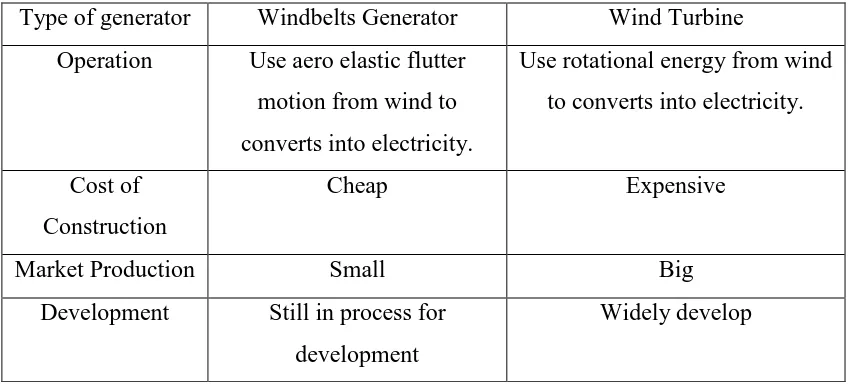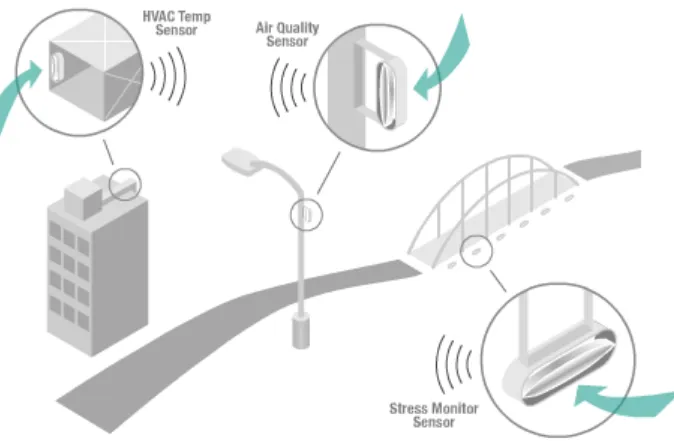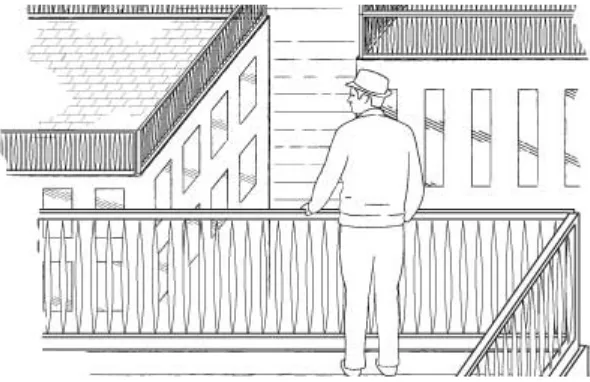UNIVERSITI TEKNIKAL MALAYSIA MELAKA
DEVELOPMENT OF DOMESTIC RENEWABLE ENERGY
USING WINDBELT GENERATOR
This report submitted in accordance with requirement of the Universiti Teknikal Malaysia Melaka (UTeM) for the Bachelor Degree of Electronic Engineering
Technology (Industrial Electronics) with honours
by
HULAMRI BIN OMAR
B071210550
900619-01-5139
UNIVERSITI TEKNIKAL MALAYSIA MELAKA
BORANG PENGESAHAN STATUS LAPORAN PROJEK SARJANA MUDA
TAJUK: Development of Domestic Renewable Energy Using Windbelt
Generator
SESI PENGAJIAN: 2015/2016
Saya HULAMRI BIN OMAR
mengaku membenarkan Laporan PSM ini disimpan di Perpustakaan Universiti Teknikal Malaysia Melaka (UTeM) dengan syarat-syarat kegunaan seperti berikut:
1. Laporan PSM adalah hak milik Universiti Teknikal Malaysia Melaka dan penulis. 2. Perpustakaan Universiti Teknikal Malaysia Melaka dibenarkan membuat salinan
untuk tujuan pengajian sahaja dengan izin penulis.
3. Perpustakaan dibenarkan membuat salinan laporan PSM ini sebagai bahan pertukaran antara institusi pengajian tinggi.
4. **Sila tandakan ( )
SULIT
TERHAD
TIDAK TERHAD
(Mengandungi maklumat yang berdarjah keselamatan atau kepentingan Malaysia sebagaimana yang termaktub dalam AKTA RAHSIA RASMI 1972)
(Mengandungi maklumat TERHAD yang telah ditentukan oleh organisasi/badan di mana penyelidikan dijalankan)
Alamat Tetap:
NO.22, Jln Basong, Kg Dato Abd
Rahman Yassin, 86000 Kluang
Johor.
Disahkan oleh:
Cop Rasmi:
iv
DECLARATION
I hereby, declared this report entitled “DEVELOPMENT OF DOMESTIC RENEWABLE ENERGY USING WINDBELT GENERATOR” is the results of my
own research except as cited in references.
Signature :………
Name : ………
v
APPROVAL
This report is submitted to the Faculty of Engineering Technology of UTeM as a partial fulfillment of the requirements for the degree of Bachelor of Engineering Technology (Bachelor Degree of Electronic Engineering Technology (Industrial Electronics))(Hons.). The member of the supervisory is as follow:
vi
ABSTRACT
vii
ABSTRAK
viii
DEDICATIONS
To my beloved family, fellow friends and lecturer’s that gives full commitment and
ix
ACKNOWLEDGMENTS
Bismillah Ar-Rahmani Ar-Rahim
In the Name of Allah the Most Gracious and the Most Merciful
First and foremost, thank to Allah for all His guidance so that I would accomplish my PSM report. As student of Universiti Teknikal Melaka Malaysia (UTeM), I have no exception from carrying out to do the Final Year Project. Because of that, I have chosen “Domestic Renewable Energy Using Windbelt Generator” as my title to project.
I also would like to thank En. Khairul Anuar Bin A Rahman as my supervisor for steering me as much as I need without any discontinuities occurs during the discussion. I deeply appreciated your hospitality and intelligence in bringing this final year project from the beginning of the semester until now.
x
TABLE OF CONTENTS ... x
LIST OF FIGURES ... xiv
LIST OF TABLE ... xvi
LIST OF SYMBOLS AND ABBREVIATIONS ... xvii
CHAPTER 1 ... 1
1.0 Introduction ... 1
1.1 Project Background ... 1
1.2 Problem Statement ... 2
1.3 Project Objective ... 2
1.4 Scope of Project ... 3
1.5 Summary ... 3
CHAPTER 2 ... 4
2.0 Introduction ... 4
xi
2.2 Humdinger Wind Energy and Windbelt Innovation ... 6
2.2.1 Micro Windbelt ... 6
2.2.2 Medium Windbelt ... 8
2.2.3 Large Windbelt... 8
2.3 Aero Elastic Flutter Energy Harvester ... 9
2.4 Influence Factors of Electricity Consumption ... 10
2.4.1 Famili Income ... 10
2.4.2 Lifestyle... 11
2.4.3 Household appliance ... 11
2.4.4 Responsibility and Knowledge ... 11
2.4.5 Consumers Behaviour’s ... 12
2.4.6 Electricity Cost ... 13
2.5 Case Study (Previous Works) ... 14
2.5.1 Samoa Hostel Windbelt... 14
2.6 Summary ... 15
CHAPTER 3 ... 16
3.0 Introduction ... 16
3.1 Flowchart Project ... 18
3.2 Block Diagram ... 19
3.2.1 Explanation ... 20
3.3 Hardware and Circuit Development ... 20
xii
3.3.2 Copper coil ... 22
3.3.3 Ribbon or Membrane ... 23
3.3.4 Neodymium Magnet... 24
3.3.5 Multicomp 2W06 Bridge Rectifier ... 25
3.3.6 Boost MCP 1640 ... 25
3.3.7 Boost LM 2577 ... 26
3.3.8 PCB Circuit Development ... 27
3.4 Summary ... 28
CHAPTER 4 ... 29
4.0 Introduction ... 29
4.1 Windbelt Generator Testing ... 30
4.2 DC Boost MCP 1640 test data ... 33
4.3 Result of the Project ... 34
4.4 Discussion on Systems ... 36
CHAPTER 5 ... 37
5.0 Introduction ... 37
5.1 Conclusion ... 38
xiii
APPENDIX B ... 44
APPENDIX C ... 46
APPENDIX D ... 48
APPENDIX E ... 50
APPENDIX F ... 53
xiv
LIST OF FIGURES
FIGURE TITLE PAGES
2.1 Some applications of the Micro Windbelt 7 2.2 Large Windbelt aim to bring wind power to
new micro grids in the city 8 2.3 Influence Factors of Electricity Consumption 10
2.4 The Buzzards’ Windbelt 14
3.1 Project Methodology Development 17
3.2 Flowchart Project 18
3.3 Block Diagram Project 19
3.4 Windbelt Generator 21
3.5 Coil windings 22
3.6 Polypropyelene ribbon 23
3.7 Neodymium magnet 24
3.8 Bridge rectifier 25
3.9 Boost MCP 1640 circuit 25
3.10 Boost LM 2577 circuit 26
3.11 Flowchart of making PCB board 27 4.1 Highest output voltage 1.06V at high
speed of table fan 30
4.2 Highest output voltage 0.56V at medium
speed of table fan 31
4.3 Highest output voltage 0.25V at low
speed of table fan 31
4.4 Wind level speed of table fan verses output
xv
4.5 Complete prototype for Development of Domestic Renewable Energy Using
Windbelt Generator 34
4.6 Can use for home appliance such as
charging laptop 34
4.7 Inverter circuit 35
4.8 Aero elastic flutter motion of magnet induced
xvi
LIST OF TABLE
TABLE TITLE PAGES
2.1 Comparison Wind generators 4
4.1 Ooutput measurement based on 3 level
xvii V - Volt
DC - Direct Current
AC - Alternate Current
VDC - Direct Voltage
VAC - Alternate Voltage
LED - Light Emitted Diode
kWh - kilowatt hour
W - Watt
h - hour
RM - Ringgit Malaysia
PSM - Projek Sarjana Muda
mW - miliwatt
1
CHAPTER 1
INTRODUCTION
1.0 Introduction
This chapter presents the overview for overall description for this project. It’s including the background of project, objective and scope. The organization of the report also state in this chapter for the preview of the report ahead.
1.1 Project Background
2
1.2 Problem Statement
Nowadays, Malaysia currently adopts a five-fuel mix (gas, coal, hydro, oil, and other sources) for electricity generation. The energy we use today comes mainly from non-renewable sources such as coal, oil, natural gas and uranium, all of which are finite resources and will be depleted. Problem also happen because unsustainable price of fossil fuels and high growing demand energy in global. Additionally, the use of these types of fuel are damaging to our health and to the environment. As individuals, your home has a direct impact on the environment. Power stations that provide our electricity, generally burn fossil fuels to supply our energy needs. Among people Malaysia also lack of exposure about renewable energy. This is to create awareness about renewable energy.
1.3 Project Objective
i. To design a sustainable and affordable of renewable electricity resources. ii. Smart way to produce electricity in home by using furniture.
iii. To reduce electrical bill.
3
1.4 Scope of Project
The project work scope is to design a suitable wind generator prototype to place at home or local building and to develop system to store the requirement electricity. These systems contain:
• Rectifier circuit
• Boost or step-up converter circuit
• Inverter circuit
• Rechargeable Battery
• Battery 12V
• AC load
For the windbelt generator, it must be vibrate efficiently to produce electricity range between 1V to 2V. The rectifier uses for this system is to convert the AC voltage from windbelt generator to DC voltage. Then, the boost or step-up converter circuit uses to boost the DC voltage to 12VDC then it flow to rechargeable battery hence charge the battery. The inverter will convert the voltage that get from charger circuit from DC voltage to AC voltage. The system is expected to produce electricity 12VDC for DC load and 240VAC for AC load.
1.5 Summary
4
CHAPTER 2
LITERATURE REVIEW
2.0 Introduction
This chapter is to summarize the literature review of the project. In order to complete this project also, some researches about the previous system also been studied and explore. It is a body of text that aims to review critical pint of current knowledge for any related information and reviews on Windbelts and awareness about electricity consumptions. These chapters also consist of aim to show all related studies, formula, result, history, type and function of Windbelts in order to show the relationship with this project.
2.1 Comparison between Wind Generators
Table 2.1: Comparison between Wind Generators
Type of generator Windbelts Generator Wind Turbine Operation Use aero elastic flutter
motion from wind to converts into electricity.
Use rotational energy from wind to converts into electricity.
Cost of Construction
Cheap Expensive
Market Production Small Big
Development Still in process for development
5
2.1.1 Windbelt Innovation
6
Until recently, the only commercially viable wind harvesting device was the turbine. Humdingers Windbelt is the first non-incremental innovation beyond this century-old approach. [2]Humdinger Wind Energy was the company that built by Shawn Frayne to market the Windbelt into worldwide. History of this Windbelt technology conceived in 2004, during a trip to Petite Anse, Haiti. Shawn Frayne working that area and found the fishing village near the coast was not connected to an electrical grid and the only lighting available was diesel powered or kerosene-based. He recognized that white LEDs powered by a very inexpensive wind generator might be able to better light homes and school in that area. Shawn has tried to design an affordable turbine-based wind generator but the turbine technology is too inefficient at these scales to be a viable option. Then, he led to a new invention because of these difficult constraints of cost and local manufacture. The new inventions call the Windbelt generator. Today, the suite of technologies and intellectual property behind the Windbelt is wholly owned by Humdinger Wind Energy, LLC (“Humdinger”). Humdinger, a Hawaii limited liability company with a wholly-owned subsidiary (Humdinger Wind Energy (HK) Limited) in Hong Kong, is primarily a research and development house focused on pushing forward the development of the Windbelt technology.Through its growing intellectual property base in the US and abroad, Humdinger manages rights to the Windbelt technology. Humdinger is seeking strategic partners interested in licensing intellectual property rights to manufacture and sell products incorporating our Windbelt technology. This company has created a several Windbelt product that use in worldwide that is Micro Windbelt, Medium Windbelt and Large Windbelt.
2.2.1 Micro Windbelt
7
Figure 0.1: Some applications of the Micro Windbelt.
8
Medium Windbelt is being developed to change turbine-based wind harvester which only cost effective on a unit size of nearly a megawatt and maintenance is expensive and difficult. This Humdinger’s product has 1-meter long and demanding 0.1kWh to 1kWh of energy per month. A single Medium Windbelt, for instance from is sized to power meshed WiFi repeaters, whereas a few units linked together can provide power to ocean navigation buoys or isolated lighting apps. The systems, like all of Humdinger's main products, are modular, in that individual units can be combined together as building blocks for larger installations.
2.2.3 Large Windbelt
A Large Windbelt shown in Figure 2.2 is engineered to bring the wind power to new places at the prices of coal. It is designed for modularity, safety and very low cost. The Large Windbelt is being developed to make installing wind energy as easy as putting up a fence. Capable of being assembled into vast arrays, with no spinning blades and very little moving mass the Large WIndbelt can be installed in all those locations that wind and solar have never been able to go.


